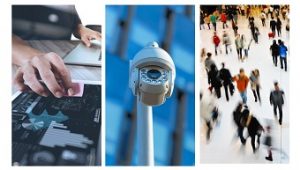
Nowadays, there is a lot of hype around data and its utility for almost any industry – from security and law enforcement to business operations and retail. While we are inundated with information about data and its significance to business success, technological development and fulfilling the promise of the Internet of Things, we don’t always get practical feedback as to how to obtain this valuable data from the resources available to us.
Security teams feel this challenge acutely. As an industry that depends on accurate intelligence and real-time information, data is vital for preventing breaches, reacting to threats, and maintaining public safety.
One of the primary resources at the disposal of security teams is video, yet extracting insights from this medium has never been particularly efficient. Monitoring video feeds takes time and – even if security teams have sufficient resources – after twenty minutes of reviewing surveillance footage, 95% percent of incidents are likely to be missed and 98% of recorded video is never even watched.
New developments in video analytics are revolutionising this reality. Video analytics based on Video Synopsis technology makes it possible to review hours of video in minutes and easily extract actionable data from video, enabling immediate and effective response. To fully understand how this works and how to retrieve these insights, we need to break down what actionable data means, how it is extracted from video and how to interpret the data output and results.
Simply put, actionable data is information that can be easily and effectively utilised. Regardless of the business sector or market, actionable video data refers to information about who and what is being viewed, as well as quantitative statistics about these elements, enabling the detection of anomalous behaviour. Video Synopsis technology analyses the video and determines all the objects in the video. It then classifies this data to make it easier for the viewer to understand who is in the video. Objects are evaluated and indexed based on factors such as size and appearance, enabling the technology to filter them into categories, such as person or vehicle. Smart Video Synopsis can deliver rich classification, drilling down to categories such as gender and vehicle type, from buses to bicycles and everything in between.
The technology also determines what the objects are doing: where and how fast they are moving, – noting any lack of movement, as well – and how long the behaviour persists. Using the who and what data, viewers now have statistical data about the video content. Having these statistics is key for understanding the baseline of activity in a video feed. Once normative behaviour has been analysed and established, the viewer can be alerted in the case of abnormal behaviour, which, for instance, could be used to indicate a security threat.
Ironically enough, the only way to extract actionable data is possessing plenty of video data. Today, there are various video analytics technologies that can extract and identify objects with deep learning techniques, using deep neural networks (DNNs) that imitate the way humans are taught and learn. Processing multiple videos and through deep learning techniques, these technologies can detect, classify, and recognise features and objects in video better and faster.
By processing more video and aggregating more metadata, the right system becomes increasingly efficient at searching, tracking, and understanding object behaviour in videos. It can be used to learn and monitor activity, closely analyse complex scenes, and present object behaviours in a detailed and organised fashion that makes it easier to evaluate. For example, increased scene coverage for occupancy, crowd and queue control, cross camera search and, recently, metadata aggregation over time trending.
Metadata is also easier to store and save than the actual video footage, because it takes up less bandwidth. Effective video analytics solutions can extract information from video in the form of metadata, quickly and cost-effectively upload the metadata to the cloud and aggregate it to generate reports and identify developing trends.
Metadata is the key for further unlocking the potential of video analytics, but, for the data to be useful, it must be presented to the user in conducive ways: Each vertical has its own requirements for ingesting and applying data from video, and video analytics offers solutions for the varying needs of every business type.
For law enforcement and safety organisations, for instance, the ability to review large volumes of video quickly is important. Video analytics based on Video Synopsis enables security teams to watch hours of video in minutes, by simultaneously presenting objects that appeared at different times in the original video. This helps investigators quickly identify threats and find targets in recorded video.
From security teams to corporate businesses to municipal bodies, having actionable data helps all organisations streamline their operations, recognise inefficient work flows and understand which behaviours and activities are most effective. The technology is developing in a direction where business intelligence offered by video analytics is becoming predictive, opening doors to more efficient business practices, from enabling faster response to prevent terror to validating investment in video across verticals and use cases.










